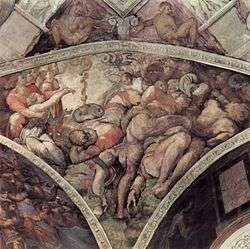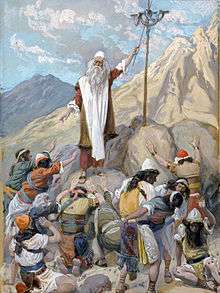Nehushtan
In the biblical Books of Kings (2 Kings 18:4), the Nehushtan (or Nohestan) (Hebrew: נחושתן or נחש הנחושת) is the derogatory name given to the bronze serpent on a pole first described in the Book of Numbers, which God told Moses to erect to so that the Israelites who saw it would be protected from dying from the bites of the "fiery serpents" which God had sent to punish them for speaking against God and Moses Numbers 21:4-9. In Kings, King Hezekiah institutes an iconoclastic reform that requires the destruction of "the brazen serpent that Moses had made; for unto those days the children of Israel did burn incense to it; and it was called Nehushtan". The term means "a brazen thing, a mere piece of brass".[1]
Alternate transliterations and translations
The name is transliterated as "Nohestan" in the Douay-Rheims 1899 American Edition,[2] as "N’chushtan" in the Complete Jewish Bible [3] and as "Nechushtan" in the Orthodox Jewish Bible.[4]
The English Standard Version of the Bible and the majority of contemporary English translations refer to the serpent as made of 'bronze', whereas the King James Version and a number of other versions state 'brass'. The Douai-Rheims 1899 edition has 'brazen'. Eugene H. Peterson, who created a loose paraphrase of the Bible as The Message (2002), opted for 'a snake of fiery copper'.[5] The reference in 2 Kings 18:4 is translated as 'brasen' in the King James Version.[6]
Serpent image

Snake cults had been well established in Canaan in the Bronze Age: archaeologists have uncovered serpent cult objects in Bronze Age strata at several pre-Israelite cities in Canaan: two at Megiddo,[7] one at Gezer,[8] one in the Kodesh Hakodashim (Holy of Holies) of the Area H temple at Hazor,[9] and two at Shechem.[10]
According to Lowell K. Handy, the Nehushtan may have been the symbol of a minor god of snakebite-cure within the Temple.[11]
In scripture
Hebrew Bible

In the biblical story, following their Exodus from Egypt, the Israelites set out from Mount Hor, where Aaron was buried, to go to the Red Sea. However they had to detour around the land of Edom (Numbers 20:21, 25). Frustrated and impatient, they complained against Yahweh and Moses (Num. 21:4-5), and in response God sent "fiery serpents" among them. For the sake of the ones who were repentant, Moses was instructed by God to erect a "serpent of bronze" which was used to heal those who looked upon it (Numbers 21:4-9).
The term also appears in 2 Kings 18:4 in a passage describing reforms made by King Hezekiah, in which he tore down altars, cut down symbols of Asherah, destroyed the Nehushtan,[12][13][14] and according to many Bible translations, gave it that name.[15]
Regarding the passage in 2 Kings 18:4,[16] M. G. Easton noted that "the lapse of nearly one thousand years had invested the 'brazen serpent' with a mysterious sanctity; and in order to deliver the people from their infatuation, and impress them with the idea of its worthlessness, Hezekiah called it, in contempt, 'Nehushtan', a brazen thing, a mere piece of brass".[1]
The tradition of naming it Nehushtan is not considered to be any older than the time of Hezekiah.[17]
New Testament
In the Gospel of John, Jesus discusses his destiny with a Jewish teacher named Nicodemus and makes a comparison between the raising up of the Son of Man and the act of the serpent being raised by Moses for the healing of the people.[18][19]
Jesus applied it as a foreshadowing event to his own execution on a stake stating, "And as Moses lifted up the serpent in the wilderness, even so must the Son of man be lifted up: That whosoever believeth in him should not perish, but have eternal life. For God so loved the world, that he gave his only begotten Son, that whosoever believeth in him should not perish, but have everlasting life" (John 3:14-16).
Charles Spurgeon preached a famous sermon on "the Mysteries of the Brazen Serpent" and this passage from John's Gospel in 1857.[20]
Book of Mormon
In the Book of Mormon, two prophets make reference to this event. The first is the prophet Nephi, son of Lehi in a general discourse,[21][22] the second is many years later by the prophet Alma.[23] Nephi tells the people that many of the Israelites perished because of the simplicity and faith required. In the latter narrative, Alma tells the people of Antionum that many of Israelites died because they lacked the faith to look at the brazen serpent. He then compared the brazen serpent to a type of Christ and exhorted the people to look to Christ and spiritually live. [24]
In art
There is a Brazen Serpent Monument on Mount Nebo in Jordan created by Italian artist Giovanni Fantoni.[25] The Cardston Alberta Temple of the Church of Jesus Christ of Latter-day Saints has a handpainted mural depicting Moses and the brazen serpent.[26]. Similarly, on the ceiling of the Sistine Chapel, Michelangelo painted a mural of the Israelites' deliverance from the plague of serpents by the creation of the bronze serpent.
See also
- Caduceus
- Idolatry
- Naassenes
- Nāga
- Ningishzida
- Ophites
- Rod of Asclepius
- Serpents in the Bible
- Serpent symbolism
- Staff of Moses
- Uraeus
- Wadjet
- Yayati (Nahusha - father of : cursed to become python).
- Snake worship
Footnotes
- 1 2 M.G. Easton M.A., D.D., Illustrated Bible Dictionary, Third Edition, published by Thomas Nelson, 1897.
- ↑ https://www.biblegateway.com/passage/?search=2+Kings+18%3A4&version=DRA
- ↑ https://www.biblegateway.com/passage/?search=2+Kings+18%3A4&version=CJB
- ↑ https://www.biblegateway.com/passage/?search=2+Kings+18%3A4&version=OJB
- ↑ All translations of Numbers 21:9 taken from BibleGateway.com https://www.biblegateway.com/verse/en/Numbers%2021:9 accessed 15 September 2015
- ↑ BibleGateway.com https://www.biblegateway.com/verse/en/2%20Kings%2018:4 accessed 15 September 2015
- ↑ Gordon Loud, Megiddo II: Plates plate 240: 1, 4, from Stratum X (dated by Loud 1650-1550 BC) and Statum VIIB (dated 1250-1150 BC), noted by Joines 1968:245f.
- ↑ R.A.S. Macalister, Gezer II, p. 399, fig. 488, noted by Joiner 1968:245 note 3, from the high place area, dated Late Bronze Age.
- ↑ Yigael Yadin et al. Hazor III-IV: Plates, pl. 339, 5, 6, dated Late Bronze Age II (Yadiin to Joiner, in Joiner 1968:245 note 4).
- ↑ Callaway and Toombs to Joiner (Joiner 1968:246 note 5).
- ↑ Lowell K. Handy, The Appearance of Pantheon in Judah, in Diana Vikander Edelman, "The triumph of Elohim", 1995, p.41
- ↑ Noth 1968, p. 156
- ↑ "The Mystery of the Nechushtan", Hershel Shanks, Biblical Archaeology Review, pp.58-63, March/April 2007.
- ↑ Joines, Karen Randolph (1968). The Bronze Serpent in the Israelite Cult The Bronze Serpent in the Israelite Cult. JOBL, 87. p. 245, note 1.
- ↑ 2nd Kings 18:4 in various translations
- ↑ 2nd Kings 18:4, many translations
- ↑ "Modern exegesis holds two different opinions in regard to the meaning of the word "Nehushtan," which is explained either as denoting an image of bronze, and as entirely unconnected with the word "naḥash" (serpent), or as a lengthened form of "naḥash" (comp. νεεσθάν in the Septuagint), and thus as implying that the worship of serpents was of ancient date in Israel. The assumption that the tradition about "Nehushtan" is not older than the time of Hezekiah is, however, not contested." Jewish Encyclopedia, s.v. "Nehushtan"; H. H. Rowley, "Zadok and Nehushtan" Journal of Biblical Literature 58.2 (June 1939:113-141) p. 132 observes, "We have no record of this Brazen Serpent before this time, save for the obvious aetiological story in Num. 8 f, which states that this sacred symbol had its origin in the Mosaic age".
- ↑ John 3:14
- ↑ Olson 1996, p. 137
- ↑ C. H. Spurgeon, "The Mysteries of the Brazen Serpent", 1857
- ↑ 1 Nephi 25:20
- ↑ 1Nephi 17:41
- ↑ Alma 33:19-23
- ↑ Cook, Carl B. "It Is Better to Look Up - Carl B. Cook". www.lds.org. Retrieved 16 February 2018.
- ↑ http://www.seetheholyland.net/tag/brazen-serpent-monument/
- ↑ "In Similitude of the Son - liahona". www.lds.org. Retrieved 16 February 2018.
References

- Noth, Martin (1968). Numbers: A Commentary (Issue 613, Vol. 7 ed.). Westminster John Knox Press. pp. 155–8. ISBN 978-0-664-22320-5.
- Olson, Dennis T. (1996). Numbers. Louisville: Westminster John Knox Press. pp. 135–8. ISBN 978-0-8042-3104-6.
External links
| Wikimedia Commons has media related to Brass serpent. |